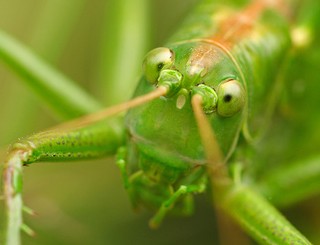
This week’s edition of Science has an interesting paper on the swarming behavior of desert locusts. It’s initiated by high levels of serotonin. I’ll wager E. O. Wilson is very excited about this.
From an informative article in the BBC News:
“Serotonin profoundly influences how we humans behave and interact,” said co-author Dr Swidbert Ott, from Cambridge University.
“So to find that the same chemical is what causes a normally shy, antisocial insect to gang up in huge groups is amazing.”
Indeed. Got me to wondering about other examples of swarming behavior. I’m thinking Super Bowl. Which got me to wondering about the Super Bowl ads mentioned by Kate Sheppard.
The Ecomagination ads made me smile. They made me feel good inside. Given the opportunity, I may find a way to thank GE for making me feel good. Drinkability made me laugh. I may subconsciously decide to buy a Bud Light the next time I’m at a bar just to rekindle that feeling.
It seems to me that the environmental community may be swarming up the wrong tree. Saving our biosphere is going to require many innovative ideas. Our best bet may be evolutionary psychology — channeling behavior. The last place anyone should go to solve problems that require massive innovation is a bureaucracy, which is where we seem to be putting most of our eggs.
More from the BBC article:
The team say their finding opens up a new idea for a locust control strategy — a chemical that inhibits serotonin and thus converts swarming locusts back to their solitary phase.
In humans, by contrast, keeping serotonin levels high is the aim of many anti-depressant drugs.
In other words, fight locust swarms with anti-anti-depressants. Great.
There are other ways to fight them. You could drive then to extinction as we did here in North America. Scientists were able to verify the identity of the grasshopper species that plagued early settlers (the Rocky Mountain Locust, Melanoplus spretus) by collecting the mummified insects found on glaciers. Occasionally a swarm would land on a glacier and become too cold to fly back off.


